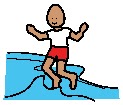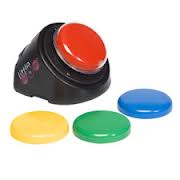 Often when people imagine using
AC, they think of really competent, literate people such as Stephen Hawking.
Although he truly is an inspiration, the process to become a literate AC user
can be daunting. How can emergent communicators get their toes wet with
augmentative communication? In this issue, we’ll explore simple ways get
started with communicating using AC.
Often when people imagine using
AC, they think of really competent, literate people such as Stephen Hawking.
Although he truly is an inspiration, the process to become a literate AC user
can be daunting. How can emergent communicators get their toes wet with
augmentative communication? In this issue, we’ll explore simple ways get
started with communicating using AC.
Non Verbal Communication
When kids aren't able to
make themselves understood they often use many forms of non-verbal
communication to express themselves such as facial expression, gestures,
sounds, and some word approximations. It's important to recognize this
communication and to reinforce it by responding in a positive way.
For example, perhaps
your child looks at toys to indicate they'd like to play. Tell them what you are
seeing and what you think it means. "I see you looking at your toys,
I think you're telling me you'd like to play". It feels great when
you are able to understand your child's non-verbal communication. Share
this skill with others so that your child can communicate with others in the
same way.
You can also capture this information in a "Communication Passport" along with other personal information that allows your child's personality to shine through. By sharing your child's areas of interest with others, you can help your child communicate about the things that are important to them. For more information and to download a template: http://www.communicationpassports.org.uk/Home/
Why Symbols?
Kids who aren't yet reading, may use symbols as their language of communication. Often kids start out using photographs because they are familiar and represent the exact item they want. We communicate for so many reasons including: to request things, to share feelings, to refuse, to ask questions, to comment and so much more. In order for kids to communicate for all of these reasons, they need to learn a symbol system to represent feelings, actions, places, describing words (big/little), and concepts (in/out, on/under, more/less).
Symbol Types and Hierarchy: This list provides the order of the easiest representations for a student to understand.
Real
Objects
Color
photographs
Black
and white photographs
Miniature
Objects
Symbols
Printed
words
Symbols Libraries: There are a variety of symbol libraries that are used in augmentative communication systems. Together with your child’s SLP choose a symbol set. Here are some examples of some commonly used symbols:
(Boardmaker)
by
Widgit (Communicate in Print Software)
by
N2Y (Online Symbol Library)
by
Prentke Romich Company
from the Bliss Symbolics Communication Institute
Canada
Access to Symbols: Talk with your clinicians or school team about the need to produce symbols at home for your child. You may also find access to symbol-making software at your child’s school or community library.
Creating Symbols and Boards: There are plenty of ready made boards that you can
access online. If you have access to Boardmaker, you can often download
them and customize them for your child. Boardmaker Community is a
website where you can download or upload these types of resources.
If you get the chance to borrow a BIGmack, a Step-by Step or a similar device….try out some of these ideas:
Download
this Handout: WhatCan I Say? -Single Message Device Ideas
Download
this Handout: WhatCan I Say? - Sequential Message Device Ideas
iPod, iPhone, iPad Options for Simple Speech Generating Devices
There are some apps that can be used as simple messaging devices if your child is able to access a button on an idevice.
Examples of Single Message Apps:
- iSpeak Button by Goatella ($3.99) https://itunes.apple.com/us/app/ispeak-button/id471583149?mt=8&ign-mpt=uo%3D4
- Sounding Board by Ablenet (Free): This app can be configured to allow 1 button on the screen but can also be used with more messages. https://itunes.apple.com/us/app/soundingboard/id390532167 * in Canada, search under iphone apps. You can adjust the size of the screen by touching 2x on the bottom right.
- Go Talk Now Lite (Free version):
This app can also be configured to allow 1 button on the screen. https://apps.apple.com/ca/app/gotalk-now-lite/id953164338
Example of Sequential Message App:
- iSpeak Sequences by Goatella ($4.99) https://itunes.apple.com/us/app/ispeak-sequences/id593930331?mt=8&ign-mpt=uo%3D4
If you get the chance to borrow a device that has more than one button (e.g. Supertalker or Go Talk), search online for some ready made overlays.
I Can...be a Star!This month, we are happy to introduce clients who are using Augmentative Communication strategies and/or equipment to participate...way to go!
Here's a way to grab people's attention...share information about your child's communication using a new tool called "Prezi". Take a look at this amazing presentation that was created to allow Abby to share information about herself with her classmates.
Brittany uses many
methods to communicate and has recently learned to use a speech
generating device (SGD) to make requests to her family, friends and teachers. Watch this video and see how she's asking for things she wants. Well done Brittany! Keep building those communication skills with your
Alt Chat SGD!
Dallas is learning to use his device to clarify his communication. Here he is using it to help read a story with his educational assistant. He uses his device to participate in the classroom - answering his teacher's questions and contributing his ideas to the class. He has also given a speech to his class about one of his favourite topics - baseball. Well done Dallas! Keep on communicating!





